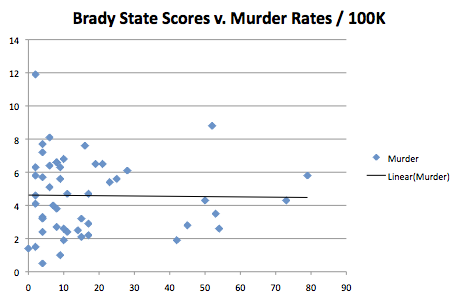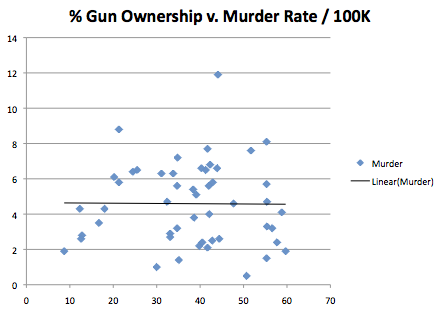Someone e-mailed today and mentioned the following:
Strictly speaking, the Bradys don’t argue that gun control will lower violent crime, they argue that it will lower the rate of violent deaths by decreasing the effectiveness of the violent criminals (and by making suicide attempts less successful).Do you have any data on how rates of gun ownership correlate to murder rates (or even to violent death rates including all suicides)?
That much is true. I have heard gun control advocates claim this. I don’t have suicide data readily handy (if someone knows a source, I can plug it into my spread sheet). I also suspect suicide will correlate some, because suicide by gun is more effective, and an option many will pick if it’s available. That’s why they use “gun death.” Â I just don’t think taking away dangerous things from people because they might hurt themselves with it is proper public policy for a free society, statistics be damned. But here’s the murder charts:
Statistically there’s no correlation here. Plotting along X are the Brady scores, and along the Y is the murder rate per 100,000 population of that state. Also, if you look at gun ownership levels versus the murder rate, you get something similarly uncorrelated:
Here we also have no correlation. We have percentage of gun ownership as X, and murder rate per 100,000 as Y. Compared to gun ownership, murder rate is random noise. So what does the murder rate correlate to? I actually did run all these numbers, but did not include them in the original post, because it was rather long. Murder correlates weakly to poverty indicators, as does violent crime. It’s uncorrelated with urban density, though Brady score is strongly correlated with urban density. I was surprised that urban density does not correlate with violent crime or murder. Not surprised urban density plays a role in how much gun control a state has.
The essential thesis stands. Gun control does not accomplish what it’s advocated to do. The typical retort from gun control advocates to statistics like these is “Well, gun control in this country has never been tried.” That might be true, but to the extent it has been tried, it’s failed. Given the constitutional and political realities present in this country, it’s an academic argument anyway. The types of gun controls promoted by the Brady Campaign do not work, unless they want to offer their own statistical model that shows it does.



http://armsandthelaw.com/archives/brady_effectiveness.pdf
Earlier article, same topic, same conclusion, with a bit more sarcasm that Sebastian’s version.
The statistics firmly fail to support the belief that laws the Bradys favor do any good at all.
Thanks for the graphs. Would be interesting to get a certain Brady board-member’s thoughts on this, but I’m not holding my breath.
Actually, suicide is less correlated than murder. The criminologists brief that I helped write for Heller points out that the actual change in D.C. homicide rates (not just murders, but also justifiable and excusable homicides) was only 5.4% (not signfiicant) and suicide decline was 1.5% (again, not significant).
The reason that suicide is so unaffected by gun availability is that guns are only slightly more effective for suicide than the methods down the list, such as hanging, or jumping off buildings or bridges. This is because guns are LESS effective than Hollywood presents (but often leaves some horrendously mutilated survivors) and the other methods are MORE effective than most people guess.
Jumping from height, I’m going to guess, is nearly 100% effective if you find a high enough bridge. I think a few people have survived a plunge off the Golden Gate, but not many. This is making me eager to plug in suicide numbers now.
Would be interesting to get a certain Brady board-member’s thoughts on this, but I’m not holding my breath
I would not hold my breath either. I don’t think what motivates her to her cause has anything to do with the effectiveness of what she’s proffering. She’s acting out a grieving process. In other words, it’s emotional for her. You’re not going to defeat that with statistics.
It doesn’t even correlate at all with Gun Homicide, if you want to go closer to their terminology.
Good stuff, thank you.
“Violent crime” numbers give the enemy an easy retort and evasion, but there’s simply no arguing with the bald fact that gun control doesn’t save lives. I guess that’s why the Bradies aren’t arguing with it.
“Jumping from height, I’m going to guess, is nearly 100% effective if you find a high enough bridge. I think a few people have survived a plunge off the Golden Gate, but not many. This is making me eager to plug in suicide numbers now.”
More than you might guess. When I lived in the Bay Area, there was one horrifying video of a woman who jumped–and survived. Nearly all of her clothing was removed by the fall. I think that after she was released from the hospital, she went back, and was “successful” this time.
Even gunshots to the head are only about 90% lethal. A fair number of people either flinch at the last second, or fail to hit a vital area. I’ve talked to a dental hygenist who has had to do regular cleanings on a person who survived a suicide attempt with a shotgun to the mouth. The results were as unpleasant as you might expect in terms of non-reconstructable injuries.
http://armsandthelaw.com/archives/brady_effectiveness.pdf
Earlier paper by me, same conclusion as Sebastian, somewhat elevated level of sarcasm.
On suicide rates, I think that the reason that the Japanese suicide rate is so much higher than ours is that they are depressed about not having access to firearms.
Guess the spam filter ate my earlier post… it contained a link, so I guess that isn’t surprising.
A few years ago, I took the FBI homicide and violent crime statistics and ran them against the state Brady grades. As Sebastian found, there is no correlation. The result is as though you had run pairs of random numbers through the regression.
From that you can say that there is no evidence that Brady laws reduce violent crime. Your chances of being murdered or raped in a Brady approved state are no different from having the same thing happen in a Brady disapproved state.
If Brady favored laws had a strong effect, you are exceedingly unlikely to reach this result. You might as well look to the prime interest rate or annual state rainfall as a predictor of violent crime.
There you go. I found it in the spam filter.
Thanks!
Their stats don’t pass on inspection and critical analysis they fail hard.
It’s religion, your not supposed to find faults only good. In the end unless you crush the belief system they will keep uttering nonsense. Here in MA we have a state close to Brady heaven and still it doesn’t work according to them. Every time they fail it’s we need a better law or to close this or that loophole. It’s all bull as they are trying to ban guns and that is built of fail. But they persist with the wishfull thinking.
Eck!
“It’s uncorrelated with urban density… I was surprised that urban density does not correlate with violent crime or murder. Not surprised urban density plays a role in how much gun control a state has.”
The first is something of a surprise to me, as well. I wpuld assume (for shame!) that increased population density would increase [casual] interaction, and opportunity if not motivation for crime.
This might help: on page 216 of my 2009 edition of the World Book Almanac, there is a section that lists all the “Deaths in the U.S. involving Firearms, by age and Sex in 2004”. The data comes from the National Safety Council. IF the National Safety Council is a Federal Agency, then you should be able to get more recent info from them. But some highlights: in 2004: Total Firearms Deaths-29,625. broken down by Category: Unintentional-651; Suicide-16,756; Homicide-11,672; Legal Intervention-311; Undetermined-235. It also breaks down by sex and age group.
If these stats are true, and there are also 300,000,000 Firearms in the U.S., that means if there was one gun used per death, then approx. 99.99% of all guns in the U.S. had NOTHING to do with ANY Human death that year.
By the way, in 2004 more people died in the following ways other than Suicide by Firearms: Motor Vehicle-44,933; Poisoning-20,950; Falls-18,807. So by using Brady Logic, to decrease the Death Rate, we need to ban Dodges, Lysol and Gravity! Hope this helps.
The National Safety Council is not a federal agency, it is a private organization. See http://www.nsc.org.
If you need suicide numbers by state, either firearm, not firearm, or “by any means”, or homicide, legal intervention, or accidental deaths by all manner of means, at the state and national level, *AND* broken down by race, you’d be hard pressed to beat the CDC WISQARS website:
http://webappa.cdc.gov/sasweb/ncipc/mortrate10_sy.html
The only real issue is that the data is always about 3 or 4 years old, so the newest numbers are from 2007.
I am not surprised that urban density does not correlate with violent crime rates. Proximity gives more opportunities for crime, but it also gives more opportunities for noticing the crime and removing the criminal from society. (There’s a Sherlock Holmes quote on the subject – I want to say it was from “Adventure of the Copper Beeches”).
What density gives you is a higher absolute value of violent crime for the same rate – so there are more crimes, but not necessarily more crimes per capita.
The lowest and vilest alleys in London do not present a more dreadful record of sin than does the smiling and beautiful countryside.
o Page 323
“Do you know, Watson,” said he, “that it is one of the curses of a mind with a turn like mine that I must look at everything with reference to my own special subject. You look at these scattered houses, and you are impressed by their beauty. I look at them, and the only thought which comes to me is a feeling of their isolation and of the impunity with which crime may be committed there.”
Thanks – I didn’t have a searchable copy handy and limited access to searching for it via internet due to being mobile.
Another possible factor influencing the firearm death/murder rates in big cities could be the proximity of large hospitals with 24-hour trauma centers.
Look at the neighborhoods in Boston where most of the gang activity is happening, and you’ll find it’s a short drive by ambulance to Boston Medical Center, home of the largest 24-hour, level 1 trauma center in New England.
This study (1993) from the University of North Carolina, Chapel Hill School of Medicine concludes:
“The study showed that the presence of a trauma center and advanced life support training were the two medical system factors that were the best predictors of the per capita county prehospital and total trauma death rates. These findings are consistent with the hypothesis that trauma centers are associated with a decrease in trauma death rates.”
Imagine if every gunshot victim in Boston had to be driven to Danvers for emergency surgery, or flown to Portland, ME by helicopter.
FWIW.
Ah – my mistake. I read “violent crime” but the last section refers to murder rates. Sebastian, what happens if you run the rates for violent crime as opposed to murders and look for correlation with population density?